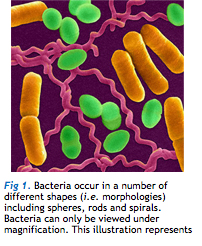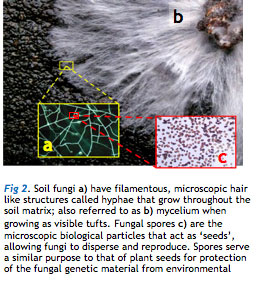Dr. Colin Bell of Mammoth Microbes gets into the evolution of plants and soil microbes, and how the two play into each other.
By Colin Bell, Ph.D
 Colin Bell
Colin BellThe following is an article produced by a contributing author. Growers Network does not endorse nor evaluate the claims of our contributors, nor do they influence our editorial process. We thank our contributors for their time and effort so we can continue our exclusive Growers Spotlight service.
Disclaimer
This article was originally posted by Mammoth Microbes. You can read the original article here.
Plants have co-evolved with soil microbes over hundreds of millions of years. When bacteria colonized the Earth and transformed the atmosphere over three billion years ago, they created conditions that made it possible for soil fungi to evolve (approximately 900 millions of years ago). Together, bacteria and fungi have shaped Earth’s soil structure and created habitable conditions for the evolution of plants around 700 millions of years ago.
Soil microbes are ubiquitous, meaning they are abundant in almost all terrestrial environments. For example, more microbes can be found in one gram of soil than there are people on the Earth! This is important because these tiny soil microbes play a huge role in supporting plant growth.
Editor’s Note: Very few places on Earth’s surface lack soil microbes. Typically these locations would be volcanic.
Bacterial and fungal species work together in clusters (i.e. consortia) to support plant growth in the rhizosphere (AKA the soil root zone) primarily by delivering nutrients and preventing disease. Soil bacteria and fungi continually increase soil nutrient availability by transforming unavailable nutrients into bioavailable forms for plant uptake (Editor’s Note: A good example would be lichens, which can take nutrients locked inside of rocks and gradually break them into a usable form). Microbes also act as a biofertilizer by releasing critical nutrients when they die. Without microbes, plants wouldn’t have the constant supply of nutrients they need to grow.
Beyond nutrient cycling, microbes also produce hormones and other chemicals that stimulate plant growth. Microbes can also prevent pathogen infection by inducing systemic acquired resistance in plants and by coating root surfaces to physically shield the plant from getting infected by pathogens. In the remainder of this article, we will discuss the key characteristics of soil bacteria and fungi, and highlight how they function to support plant growth.
Welcome to the Invisible World of Soil Bacteria
Soil bacteria represent some of the smallest single-celled organisms on Earth. Scientists have classified well over ten million unique bacterial species and, like most life on Earth, bacterial species can occur in a number of different shapes and sizes (referred to as morphologies) including spheres, rods and spirals (Fig 1). There are approximately 5×1030 bacterial cells covering the surface of the Earth (AKA 5,000,000,000,000,000,000,000,000,000,000 cells!). This means that the cumulative soil bacterial biomass across the world is greater than all plant and animal biomass combined.

Free-living soil bacteria can function in a wide range of environmental conditions and live in symbiotic (mutualistic or parasitic) relationships with plants. These bacteria are well known to improve soil nutrient conditions in the rhizosphere (i.e. root zone), filter out soil contaminants and heavy metals, and compete with disease-causing organisms.
In modern cannabis cultivation practices, beneficial bacteria are primarily used as inoculants to promote plant growth by increasing plant nutrient uptake. One means by which bacteria accomplish this is through the release of specialized proteins called extracellular enzymes into soil and soilless media. Enzymes are not living things, but are chemical catalysts that function to break down nutrient-rich molecules into bioavailable forms. Soil bacteria can produce many different functional groups of enzymes to cycle important macronutrients such as nitrogen and phosphorus for plant uptake.
Soil bacteria also make nutrients available by facilitating ion exchange. They accomplish this by secreting organic acid compounds into soil and soilless media, which act to release chemically-bound nutrients for plant uptake. For example, phosphorus (P) is an essential plant macronutrient that is not readily bioavailable in soils due to its high sorption capacity. Even when soluble phosphate fertilizers are added to soils and other growth media, up to 70% can become immediately unavailable due to chemical binding and transformations. Beneficial bacteria can naturally unlock bound Phosphorous, transforming it back into available forms to maximize its availability for plant uptake.
Plant growth is also often limited by iron because of the very low solubility of ferric iron (Fe3+). Iron is essential for plants because it plays a crucial role in metabolic processes such as DNA synthesis, respiration, and photosynthesis. Beneficial bacteria can mobilize iron for plant uptake by producing compounds called siderophores (i.e. high-affinity, iron-chelating compounds), which acquire and make Fe3+ ions readily available for plant uptake.
Some beneficial bacteria produce a class of hormones called auxins, which are essential for plant root formation and shoot development (Editor’s Note: IBA is one of the first auxins discovered). Beneficial bacteria can produce other plant hormones as well, such as gibberellins and cytokines, both of which have been shown to stimulate shoot development.
Lastly, beneficial soil bacteria induce disease resistance by producing compounds such as lipopolysaccharides, salicylic acid, and siderophores, which active plant defense mechanisms such as phytoalexins (a chemical that inhibits parasite growth) and other pathogen-related proteins. Beneficial soil bacteria can also physically coat plant roots – acting as a biological shield against pathogenic bacteria, fungi and viruses.
Entering the Fungal Kingdom
Scientists have classified seven primary fungal groups (AKA phyla) and over 70,000 unique fungal species. Soil fungi have filamentous (hairlike) structures called hyphae that grow throughout the soil and along plant root surfaces (Fig 2a); also referred to as mycelium when growing in concentrated tufts (Fig 2b). Fungi produce microscopic spores, providing a protective sheath similar to those of plant seeds, allowing fungi to protect their DNA from environmental damage while spreading to other regions (Fig 2c).

Soil-borne fungi are generally considered the primary decomposers on Earth. However, the beneficial soil fungi that promote plant health can be more specifically categorized as either decomposers or mutualists. Of these, the three functional categories that we will discuss in this article include saprophytic fungi, ectomycorrhizal fungi and arbuscular mycorrhizal fungi.
Saprophytic fungi
Saprophytic fungi are the primary decomposers that live in all terrestrial ecosystems. They live freely in soils and are quite capable of degrading difficult substrates such as lignin and soil pollutants. As decomposers, these fungi improve soil quality by decomposing complex carbon compounds to increase soil organic matter. This is a critical step for nutrient cycling because organic matter helps soils retain nutrients and moisture.
Ectomycorrhizae (EcM)
Ectomycorrhizal (EcM) fungi form symbiotic relationships with some plant species by forming a dense hyphal sheath known as the mantle, which surrounds the root surface (Fig 3a). Unlike other mycorrhizae, EcM fungi do not infect their plant host’s cortical cell walls, but instead form a hyphal “net” between the plant’s epidermal and cortical root cells (Fig 3a), commonly known as a Hartig net. EcM fungi primarily benefit plants by transporting nitrogen from the surrounding soil to improve plant nitrogen uptake, functionally acting as extended roots for the plants. In exchange, plants supply the fungi with labile carbon via roots exudates. EcM fungi demonstrate low host specificity, meaning that many different fungal species form symbiotic relationships with many different plant species.

Editor’s Note: EcM fungi commonly feed nitrogen to multiple plants and get fed carbon compounds such as sugar in return.
Arbuscular Mycorrhizal (AM) Fungi
Glomus is the largest genus of arbuscular mycorrhizal (AM) fungi. Approximately 80% of the plant species on Earth are affiliated with AM fungi. Scientists have identified approximately 85 different AM fungal species.
The symbiotic interactions between plants and AM fungi originated at least 460 million years ago. These ancient relationships evolved from both free-living saprophytic fungi that over time became endosymbiotic with plants, and from parasitic fungal interactions that developed into mutually beneficial relationships. Likewise, AM fungi are taxonomically defined as non-monophyletic (meaning that they not descended from a common evolutionary ancestral group, but several different groups).
AM fungi are differentiated from EcM fungi in several ways. For example, AM fungi infect their hosts by penetrating the root cortical layer (Fig 3b). Instead of transporting nitrogen to the plant, AM fungi promote plant growth by transporting soluble phosphorous to the plant from the surrounding rhizosphere. Likewise, the plant hosts supply AM fungi with labile carbon (via roots exudates) internally at arbuscular exchange sites.
AM fungi generally lack the ability to produce extracellular enzymes that break down nutrients, and strictly serve as a transport vessel by growing with plant roots to extend the capacity of the plant to take up nutrients from the surrounding environment. Nonetheless, many studies have cited that plants that have established symbiotic relationships with AM fungi demonstrate increased drought tolerance.
Although there is no clear evidence to suggest that AM fungi exhibit specific plant hosts for colonization, several studies have shown that AM fungi exhibit plant-specific chemotaxis (the movement of an organism in response to specific chemical stimuli). This suggests that some AM fungi prefer specific plant hosts. Furthermore, environmental conditions such as moisture, soil pH, and cation exchange capacity can have a strong influence on AM fungal colonization with plants. For example, many studies have shown that AM fungal hyphal growth significantly declines in fertilized soils that have higher levels of nutrients. Likewise, research has shown that practices such as reduced tillage and lower fertilizer usage will optimize the establishment of AM fungal colonization with host plants.
Editor’s Note: This is likely because the mutualistic exchange between the host plant and AM fungi has a significant cost to it, and, in rich soils, the cost is too high for the potential gain. In poor soils, the cost for the host plant is small compared to the potential gain.
Implementing Microbes into Cultivation Practices
Many scientific studies have shown that tiny soil microbes play a large role in growing healthy crops and increasing plant yield. While most growth media contains microbes capable of cycling nutrients, there are now commercially-available organic microbial formulations with superior functionality. Modern microbial biostimulants can improve plant growth and maximize yields by increasing nutrient availability, preventing pathogens and stimulating plant growth.
Functionally-targeted microbial inoculants represent the next-generation of green technologies which will support agriculture management across many crops to help farmers meet global production demands. The future success of cultivation practices will depend on new biological solutions to drive sustainable improvements in plant quality and productivity for decades to come
10 Best Gift Ideas for Cannabis Connoisseurs and Growing Aficionados (2022)
December 7, 2022Developing and Optimizing a Cannabis Cultivation System
December 14, 2021Dealing with Insomnia: How Can CBD Help?
December 10, 2020Your Guide to Sleep and CBD
December 7, 2020
Do you want to receive the next Grower's Spotlight as soon as it's available? Sign up below!
Resources:
-
Want to get in touch with Mammoth Microbes? They can be reached via the following methods:
- Website: https://mammothmicrobes.com/
- Email: info@growcentia.com
- Phone: (970) 818-3321

Do you have any questions or comments?

About the Authors
Growcentia was founded by a team of three Colorado State University PhD soil microbiologists that share a passion for enhancing soil health and promoting sustainable agriculture. Using innovative proprietary technology, this team developed an approach to identify and apply nature’s very best microbes to improve nutrient availability to plants.